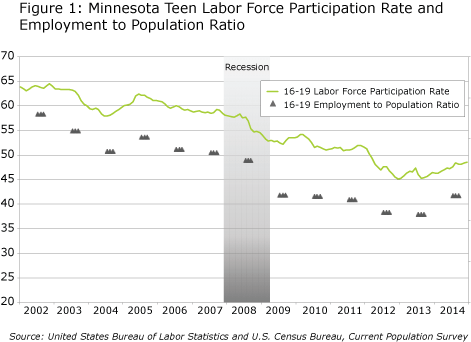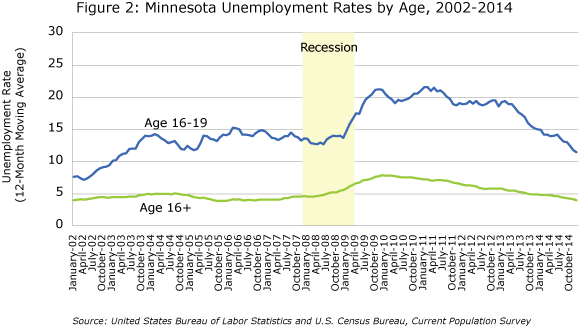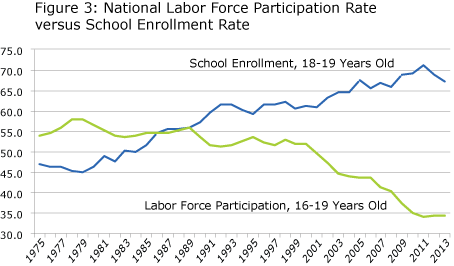by Nick Dobbins
March 2015
As Minnesota teens begin to look forward to the warm weather and school break coming in the summer, the job seekers among them will be faced with a challenging if improving labor market. While the teen market appears to be gathering momentum in recent years, and indeed improved dramatically from 2013 to 2014 as it continues to struggle in its recovery from the recession, there is no doubt that it is still a very different place than it was before the 2008 recession.
As we can see in Figure 1, labor force participation among teens has generally been declining or stagnant for the better part of the last 15 years. It has been steadily declining nationally since at least the mid-1970s. However, 2014 brought a long-awaited, if unexpected, uptick to the teen labor force participation rate in Minnesota. In the summer (July-September) of 2013 it averaged 45.6 percent. In 2014 that rate grew to 48 percent. The Employment-to-Population Ratio also increased in 2014, countering another long-term trend with the first improvement in that category since 2005. While the last year brought improvement in those telling metrics, you can see that the levels for both are still markedly lower than they have been in the past. In the summer of 2002 the labor force participation rate for 16-19 year olds in Minnesota was roughly 64 percent, with 58 percent of that population holding summer jobs. By 2014 the participation rate was only 48 percent, and just 42 percent of Minnesota teens worked summer jobs.

While a greater proportion of teens were actively looking for work in the summer of 2014, the increased competition for jobs did not seem to hurt the overall employment rate, as is sometimes the case. Unemployment rates also improved fairly significantly last year, continuing a trend that started in early 2013 of steadily falling unemployment for the teen demographic. In the summer of 2013 an average of 16.7 percent of Minnesota teenagers were unable to find jobs. That rate improved to 13.2 percent in 2014.
While teen unemployment has been dropping quickly in recent years, we see a small blip in the series as rates crept up slightly between April and June of 2014 before resuming their decline. It may or may not be a coincidence that Minnesota’s minimum wage increase law was passed in April, as national unemployment rates for this age group also increased at the same time.1
This recent decline is welcome news as unemployment among teens seemed to have been stuck at its new high levels for some time, even after overall unemployment began to drop in 2010. As Figure 2 illustrates, when the recession hit, the unemployment rate in Minnesota for 16-19 year-olds shot up, moving from 13.6 percent in December 2007 to as high as 21.2 percent in 2009. It didn’t get below 18 percent after that until June of 2013 when it hit 17.7 percent. It has been steadily dropping since then, however, reaching a low of 11.4 percent in December of 2014, the last month included in this study. It may well be that over the past year or two the overall market finally improved enough that employers are beginning to look at younger workers again for positions that they had previously been able to fill with more experienced employees. Regardless of the cause, this improvement in unemployment rates suggests an easier time for summer job seekers in 2015.

One new variable in the teen labor market is Minnesota’s recent minimum wage hike. In August of 2014 our new law went into effect. It increased the minimum amount workers in the state can be paid. Firms with revenue of less than $500,000 will have a minimum wage of $6.50 an hour and those whose revenue is $500,000 or higher will be required to pay $8.00 an hour. That was the first phase of the law, and increases will continue through 2016 when the large-employer minimum will be $9.50. Because teenagers are more likely to be relatively unskilled and just starting their working lives, they are much more likely than the general population to find themselves working in the lowest paying jobs. A DEED analysis of Minnesota’s low-wage workers, done in anticipation of the new minimum wage law, showed that in 2012 jobs paying less than the new minimum wage were most concentrated in one of two industries: Accommodation and Food Service, in which 58.5 percent of jobs would be affected by Minnesota’s new minimum, and Retail Trade, where 44.1 percent of jobs would be affected.2
Not surprisingly, of the 20 distinct industry sectors, these are exactly the same ones that generally employ a higher proportion of young workers. In the summer of 2013 Accommodation and Food Services had 30,562 14-to 18-year-old employees, and Retail Trade had 19,753. The next highest number of teen workers came in Health Care and Social Assistance, which employed just 5,812. Well over half the 14-18 year-olds with summer jobs in 2013 worked in one of those two industries.3 Nationwide, the Bureau of Labor statistics estimates that in 2013 roughly 19.5 percent of workers age 16 to 19 made at or below the federal minimum wage compared to roughly 4.3 percent of all workers 16 and over.4
Last year, we wondered how the change in the minimum wage would affect young Minnesotans’ desire to join the labor market and the availability of jobs for them. The labor force participation rate ticked up from 55.7 to 56.6 percent in August, a month that generally sees declines.1 The participation rate for the nation declined during the same time period. The available data do not give us enough information to identify any cause for this movement with complete confidence. However, the widely-publicized increase in the pay floor for many of the jobs available to teenagers could easily explain this small shift in the larger movement away from working. It will be worth watching the movement in teen labor force participation rate over the next couple of years to see if an increase continues to accompany the rising minimum wage.
While the recent increase in teen engagement with the labor force is an interesting topic to explore, the larger trends still suggest that young Americans are continuing to delay the start of their work lives in larger and larger numbers. There are a variety of reasons this could be happening, but perhaps the most popular theory is that as education beyond a high school diploma has become more important to making a good living in America, teens have shifted their focus away from entering the labor market right away and towards pursuing education, internships, or other opportunities that may help them more in the future. Figure 3, which shows the labor force participation rate of 16-19 year-olds along with the school enrollment rate for Americans the traditional age of recent high school graduates (18 and 19 year-olds), illustrates these shifting priorities. For many years more and more people have been continuing their education after they reach adulthood, while fewer teens have been immediately jumping into the workforce. This trend is also prevalent in Minnesota, where the college participation rate of recent high school graduates increased 9 percent from 1996 to 2013 (61.5 to 67 percent) according to the Minnesota Office of Higher Education.

Regardless of the cause, it is undeniable that the labor market for teenagers has changed dramatically in recent years. While some Minnesotans are deferring entering the job market for a future time, for many teens finding a summer job remains an important step to building their careers and economic stability. Summer jobs offer young Minnesotans a chance to learn the basic job skills that employers will look for as they move forward in their careers. They help teens develop connections with employers, bolster their resumes for future job and college applications, and provide income that can create a bridge for those looking to begin their work lives immediately or help those who seek further education cover some of the rising tuition costs.
A number of organizations in the state are aimed at helping young people navigate the job market. Many have a specific focus, such as woodworking, agriculture, or environmental stewardship. In addition to the programs listed below, DEED also provides avenues of assistance for people who come from low income families or have other barriers to employment. The MN Youth Program, Youthbuild Program, and Workforce Investment Act Youth Programs all provide services to youth who are seeking employment. You can find more information on these programs, including lists of service providers searchable by county.
If you’re a Minnesota teen looking to join the workforce, you can improve your chances by having a well written resume that has been proofread by at least one additional person, finding as many references as possible from people you know already in the workforce, and being sure to pursue whatever opportunities you’re able to find. While it may be difficult to find a job in the current market, being successful this summer may make a big difference in your work life later on.
Selected Minnesota Youth Employment Programs and ServicesThis is a partial list of Minnesota youth employment programs and services. Many available opportunities are not listed here so please do your own research on what may be available in your community. Cookie Cart: bakery operations (paid), career readiness, workforce skills, and customer service, North Minneapolis
Elpis Enterprises: woodworking, screen printing, and experiential workshops, St. Paul EMERGE StreetWerks: summer employment program and youth services, Minneapolis
Minnesota Conservation Corps: environmental services, statewide
Minnesota Landscape Arboretum, Urban Garden Youth Employment: entrepreneurship and leadership jobs in a variety of programs for youth age 12 to 19, Metro
Right Track: paid internships and career development opportunities for low-income students, St. Paul
Tree Trust Youth Summer Employment Program: paid work in a variety of positions in the Twin Cities metro area. Youth Express: Saint Paul area program that includes a 15-session”Urban Apprentice” class and paid internship opportunities at a bike shop or clothing store Youth Farm & Market Project: personal development and farming, Minneapolis and St. Paul YouthLead: services for low-income Ramsey County youth, ages 14-21. Includes skill training and employment opportunities. |
1United States Bureau of Labor Statistics and U.S. Census Bureau. 2014 Current Population Survey.
2Casale, Oriane and Mustapha Hammida, “Minnesota’s Low-Wage Sector.” Minnesota Economic Trends.
3U.S. Census Bureau, Longitudinal Employer-Household Dynamics, Quarterly Workforce Indicators for Minnesota, 2013.
4U.S Department of Labor, Bureau of Labor Statistics, March 2014. “Characteristics of Minimum Wage Workers, 2013.